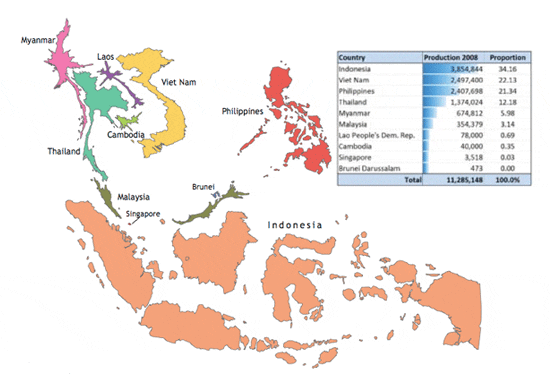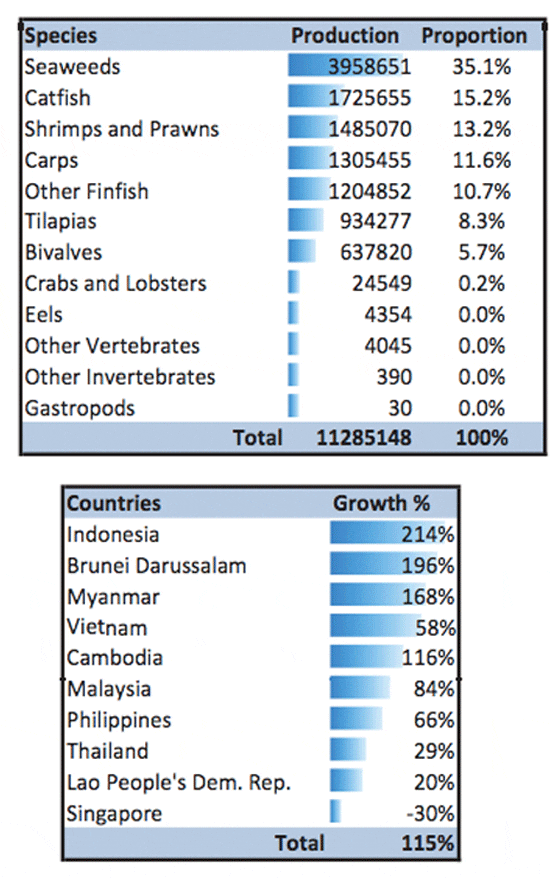Background
This global review of aquaculture aims to inform policy makers about the impacts of aquaculture on the environment and to stimulate debate on the optimal animal food production systems for tomorrow. The ASEAN region is, from supply and demand perspectives, an important center for aquaculture. This short brief highlights some of the key study findings that are relevant to the ASEAN region.
ASEAN Aquaculture
Aquaculture is one of the fastest growing food production sectors in the world. It has grown at an average annual rate of 8.4 per cent since 1970 and total production reached 65.8 million tonnes in 2008. ASEAN is globally an important aquaculture region, with ASEAN members of Brunei, Cambodia, Indonesia, Laos, Malaysia, Myanmar, the Philippines, Thailand, Singapore and Vietnam together producing 11.3 million tonnes, around 17 per cent of the world total. Aquaculture is a signifi cant part of the economy, food supply and rural livelihoods within ASEAN. Indonesia dominates the aquaculture production of the ASEAN region with a yearly production of 3.85 million tonnes, followed by Vietnam, Philippines and Thailand with 2.50, 2.41 and 1.37 million tonnes respectively (see Fig 1).
Growth in aquaculture production in the ASEAN region has been fast, at 115 per cent from 2003-2008 (Fig. 2). During the same period, China showed a growth rate of 30 per cent, Oceania 37 per cent, South America 39 per cent and Africa 81 per cent. Thus, compared to other regions in the world, the ASEAN countries have shown an exceptionally high growth. Indonesia, Brunei and Myanmar had the greatest growth rates in the ASEAN region with 214 per cent, 196 per cent and 168 per cent respectively.
The ASEAN region has a diverse mix of aquaculture systems and species. After seaweed, catfish constitutes the largest species group and made up 15.3 per cent of the total production during 2008. Shrimps and prawns, carps and other finfish also made up a large proportion with 13.2 per cent, 11.6 per cent and 10.7 per cent of the total production respectively. Ponds and off-bottom culture constitute the most common production systems with 44 per cent and 38 per cent of all production systems respectively. As elsewhere, rapid growth of aquaculture in ASEAN has raised questions concerning the environmental sustainability of industry growth. Central to these concerns are the demands aquaculture places on biophysical resources (inputs) and the demands placed on the environment from wastes (outputs). Using the Life Cycle Analysis method the Blue Frontiers study examined current demands on environmental resources and the consequent levels of environmental impact.
Figure 1: ASEAN aquaculture production in 2008. Land areas are adjusted proportionally to reflect production volumes.

Figure 2: Aquaculture growth in the ASEAN region between 2003 and 2008 (seaweed included) and production of aquaculture species groups (tonnes) in ASEAN countries in 2008. Seaweed constitutes the largest group, followed by catfish, shrimp/ prawn and carp.

Major implications for ASEAN
The major findings from the Blue Frontiers study are provided in the report and associated briefs (www.worldfishcenter.org/global_aquaculture/ ). Below we highlight some of the key implications and recommendations for ASEAN.
Life cycle analysis The diverse aquaculture commodities produced in the ASEAN region create varying demands on ecosystem resources and environmental impacts. Taken from the Blue Frontiers report, Figure 3 summarizes the global average impact per tonne of product for the major aquaculture species groups. Shrimp, prawn and freshwater finfish appear in several impact categories, including eutrophication, biotic depletion (the quantity of wild fish needed to produce acceptable feeds containing the necessary quantity and variety of oils and fats), and land use. Bivalves and seaweeds, widely grown in the region places notably low demands on environmental resources and actually reduces eutrophication by absorbing nutrients from the water.
The study also highlighted that species cultured in the same system in different countries showed considerable variance in their impacts. For more than half of the comparisons, the best performing nations demonstrated more than 50 per cent lower impact levels than the worst. This is due to a combination of differences, both in production practices where farm level choices and management exert significant influence on impacts, and in systemic country-specific conditions (such as the method of energy production) over which fish farmers often have little or no control. Growing the aquaculture sector in ASEAN requires identifying and investing in improvements in environmental performance.
Figure 3: The relative environmental impact per tonne of product categorized by species; Eutrophication (kg PO 4 eq); Acidification (kg SO2 eq); Climate Change (kg CO 2 eq); Land Occupation (ha eq); Cumulative Energy Demand (Mj); Biotic Depletion (kg)

Global aquaculture production growth is likely to continue along a similar trajectory to the recent past for at least the next five years and by 2020 available estimates suggest that production will be between 65 and 85 million tonnes. Estimates out to 2030 have a wider margin of error; here a conservative range is between 79 and 110 million tonnes. ASEAN will experience continued growth in seafood demand. Forecasts based on current population trends, and maintaining annual per capita consumption of 30.1kg/ year, predict 2.4 million tonnes of additional demand by 2020, and 5 million tonnes by 2030. Aquaculture is expected to be a major supplier to meet that new demand.
Future demand depends partly on population growth, but primarily on the fact that wealth and urbanization will continue to increase. As ASEAN wealth continues to grow, demand for fish will follow suit. The growing middle classes in the ASEAN region are where we can expect demand for fish to rise most significantly.
The ASEAN demand for meat will also increase, which will bring with it its own environmental demands. In this respect, fish have an important advantage compared to livestock because they are more effi ient when it comes to converting feed into biomass. Therefore, aquaculture has clear benefits in this respect over meat production for human consumption. Where natural resources are limited, policies that promote fish farming over other forms of livestock production in the ASEAN region should be considered.
Current trends indicate that the majority of the increase in global aquaculture production to 2030 will come from South and Southeast Asia, with ASEAN as a major producing region. ASEAN countries will therefore be faced with important challenges to future environmental management of the aquaculture sector.
Policy reform and research can reduce the overall environmental impact in the ASEAN countries. As elsewhere, there is significant potential for large improvements in efficiency across all aquaculture commodities. Shared learning of best practice across the region could offer significant opportunities to close efficiency gaps.
The following core recommendations are offered to policy makers, development and environmental organizations, and industry professionals:
- Support innovation in the aquaculture sector, especially the development of technologies that make best use of land, water and feed resources and that minimize demands on environmental services.
- Ensure that the regulatory environment keeps pace with sector development and support policy analysis and development that internalizes into aquaculture enterprises the costs of its environmental impacts.
- Develop capacity in national agencies for sector regulation and for monitoring and compliance.
- Monitor carefully how supply and demand for fish is evolving to ensure that support and investment are appropriate to the market opportunity.
These core recommendations apply globally, but all are considered relevant over the next three to five years in the ASEAN region.
Investing in science and technology will continue to be important for achieving more sustainable development. The following are among the key areas for improvement that are particularly relevant for ASEAN:
- Reduce the dependency of some aquaculture production systems on fi shmeal and fish oil, and where used assuring such ingredients derive from more sustainable sources.
- Increase use of water and energy audits to foster better practices that reduce environmental resource demands.
- Invest in improving fish strains through selective breeding. Breeding programs have yielded impressive improvements in fish growth rates and further gains can be expected. In addition, efforts in ASEAN should also focus on selection for feeding efficiency and disease resistance.
- Climate change implications cannot be ignored. Aquaculture is a relatively small contributor to greenhouse gas generation but climate change will affect the industry. The most likely outcome is that there will be a shift in the location of aquaculture from areas that become unsuitable to new areas that become more suitable. Analysis of vulnerabilities and adaptation strategies are required.
Summary
ASEAN will remain a global growth center for fish supply and demand. The sector has the capacity to meet this increased demand but to do so governments and industry will need to engage pro-actively. In particular, efforts will be needed to stimulate investment in aquaculture, and evaluate research and policy development needs along the entire value chain from inputs to consumer markets. The environmental impacts of the growth needed to meet the demand for fish can be managed through innovation, strengthened policy, capacity building and monitoring. From a human welfare perspective, supporting development of aquaculture that delivers sustained supplies at affordable prices for poor consumers will also be important. In areas where production is feasible, but markets are weak there is also a role for aquaculture as a household livelihood and food and nutrition security strategy.
June 2011
